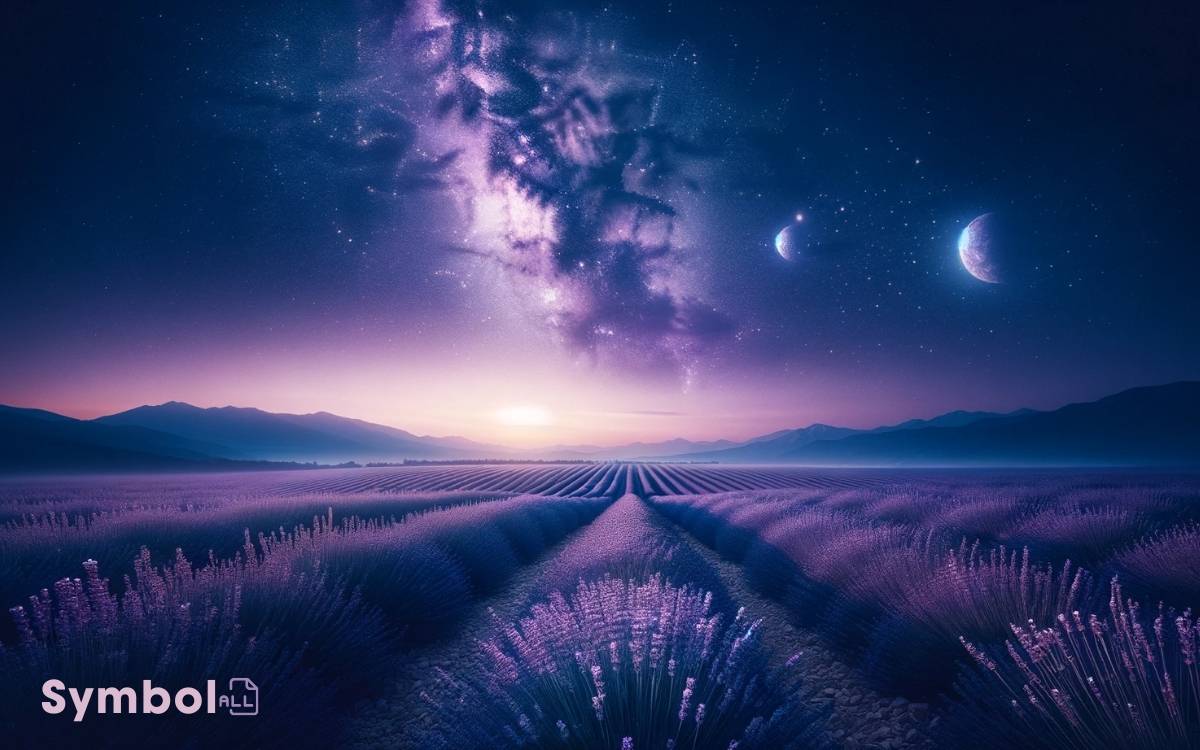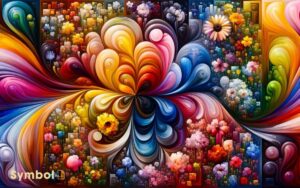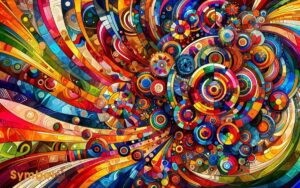What Does the Color Lavender Symbolize? Calmness & Serenity
The color lavender carries a rich tapestry of meanings that transcend time. You’ll find it symbolizes serenity and spirituality, echoing ancient uses in rituals for its calming presence. Its hue, historically hard to create, once marked royalty, suggesting exclusivity and elegance.
Today, lavender embodies more; it’s tied to creativity, mindfulness, and even gender fluidity, reflecting contemporary values. It prompts a sense of inner peace, aiding in meditation and mental health, while also keeping its mystic roots in love and devotion.
Lavender’s multifaceted symbolism invites you to explore its influence across various aspects of life, offering deeper insights into its enduring allure.

Key Takeaway
Historical Significance
Lavender’s historical significance is deeply rooted in ancient civilizations, where it was revered not just for its aromatic qualities but also for its medicinal and spiritual uses.
You’ll find that in comparison to other plants, lavender held a unique position across various cultures.
The Egyptians, for instance, used it in their mummification processes, valuing its preservative and fragrant properties.
Meanwhile, the Romans utilized lavender for bathing, cooking, and scenting the air, showcasing its versatility. This multifaceted use highlights lavender’s unparalleled status in ancient societies.
It’s fascinating to observe how lavender’s symbolism evolved, maintaining its essence of purity, calmness, and healing, yet its applications and perceived value varied considerably across different civilizations.
This contextual analysis underscores lavender’s enduring appeal and its profound impact on human history.
Royalty and Nobility
Throughout history, royalty and nobility have embraced lavender, showcasing its elevated status and symbolic significance in elite circles.
This color, with its soft yet distinct hue, not only adorned the fabrics and decor of palatial residences but also became a marker of prestige and distinction.
You’ll find that lavender’s association with royalty isn’t arbitrary; it’s deeply entwined with the scarcity and cost of purple dyes which, in ancient times, were accessible only to those of high status.
Comparatively, while blue and red were also royal colors, lavender’s unique blend conveyed a sense of delicate power and exclusivity.
This historical context enriches your understanding of why lavender still carries connotations of elegance and regality, subtly influencing contemporary fashion and design in ways that nod to its noble past.
Spirituality and Enlightenment
As you shift from the regal symbolism of lavender to its spiritual dimensions, you’ll find that the plant’s significance deepens.
Its essence has been long associated with the pursuit of inner peace and holds a mystical place in various cultural practices, positioning it uniquely among both ancient and modern spiritual symbols.
Comparatively, while royalty and nobility focus on the external and societal, spirituality and enlightenment with lavender emphasize an introspective journey, highlighting a distinct shift towards personal growth and understanding.
Inner Peace Pursuit
Seeking inner peace often leads individuals to explore the spiritual and enlightening qualities of lavender, a symbol deeply intertwined with tranquility and mental clarity.
This connection isn’t arbitrary; lavender’s serene hue reflects a balance between the stimulating energy of red and the calming presence of blue.
This unique blend not only aids in meditation practices but also encourages a deeper introspection, setting it apart from other colors commonly associated with spirituality, like white or gold.
You’ll find that lavender promotes a sense of calmness essential for inner peace, making it a preferred choice in spaces dedicated to contemplation and self-discovery.
Its distinctive color and scent work in harmony, enhancing your pursuit of enlightenment by creating an environment conducive to exploring your inner thoughts and emotions without the distractions of the external world.
Mystical Associations Explored
Lavender’s mystical allure extends beyond mere tranquility, serving as a beacon for those delving into the domains of spirituality and enlightenment.
This color’s essence encourages you to transcend the physical, inviting introspection and a higher state of consciousness.
Unlike the grounding energies of earthier tones, lavender lifts your spirit, promoting a connection to the celestial spheres.
It’s akin to the difference between standing firmly on the ground and floating amidst clouds—both positions offer perspective, yet the latter encompasses a broader, more spiritual vista.
In this light, lavender doesn’t just soothe; it enlightens, offering a path to understanding beyond the tangible. It’s a bridge between the known and the mystical, urging you to explore and embrace the depths of your own spirituality.
Calmness and Serenity
In the domain of aromatherapy, lavender stands out as a beacon of calmness and serenity, offering a peaceful respite from the chaos of daily life.
| Aspect | Lavender | Comparative Element |
|---|---|---|
| Psychological Impact | Reduces anxiety | More soothing than green |
| Physical Response | Lowers heart rate | Quicker relaxation than blue |
| Symbolic Meaning | Peace, tranquility | Deeper serenity than white |
| Cultural Significance | Healing, purity | Broader acceptance than pink |
Femininity and Grace
Beyond its calming qualities, lavender also embodies femininity and grace, often compared to the elegance and softness traditionally associated with these traits.
Historically, the color lavender has been tied to the delicate and gentle aspects of femininity, evoking a sense of refined beauty and poise.
In cultural contexts, it represents the nurturing and caring side of womanhood, offering a visual cue for qualities like empathy and compassion.
This color’s association with gracefulness isn’t just about physical elegance; it extends to the demeanor and attitude that exude dignity and respect.
When you see lavender used in fashion or decor, it’s not merely a choice of palette but a subtle nod to these enduring qualities of femininity and grace, contrasting sharply yet harmoniously with more vibrant or bold symbols of female strength and empowerment.
Creativity and Imagination
As you explore the symbolism of lavender, you’ll find it’s not just a symbol of femininity and grace but also a potent emblem of creativity and imagination.
Its unique color and fragrance have the power to spark artistic inspiration, contrasting sharply with the more subdued symbols of creativity found in other flora.
Lavender stands out by enhancing creative thinking and painting imagination’s influence in vibrant, broad strokes, setting a distinct tone for artistic endeavors.
Sparking Artistic Inspiration
Lavender’s distinctive hue and fragrance have long inspired artists, serving as a muse that stimulates creativity and frees the imagination.
This color embodies a unique blend of serene tranquility and vibrant energy, making it a powerful catalyst for artistic expression.
When you compare lavender to other colors, its ability to evoke both calm and creativity stands out, setting it apart as a source of inspiration.
| Aspect | Lavender’s Influence | Comparative Color |
|---|---|---|
| Emotional Impact | Soothing yet stimulating | Blue is calming, but less stimulating |
| Symbolism | Creativity, elegance | Green symbolizes growth, but less creativity |
| Usage in Art | Invokes imagination | Red captures attention, but is less nuanced |
| Cultural Significance | Represents refinement | Yellow signifies happiness, but less sophistication |
Lavender encourages artists to explore a spectrum of feelings, from contemplative to euphoric, enabling a deep exploration into creative endeavors.
Enhancing Creative Thinking
Delving into the realm of creative thinking, lavender acts as a catalyst that sharpens imagination and fosters innovative ideas, setting it apart from other colors which may only stimulate the senses superficially.
Unlike the vibrant reds that command attention or the tranquil blues that soothe the mind, lavender’s unique hue intertwines both stimulation and calmness, creating an ideal environment for creative thought.
It nudges you towards a state where your mind can wander freely, yet remain focused enough to guide those wanderings into productive ideas.
This balance is essential in creative processes, where too much excitement can scatter thoughts and too much calm can stifle them.
Lavender’s gentle nudge towards imaginative exploration makes it a powerful tool in enhancing creativity, offering a nuanced approach that other colors might lack.
Imaginations Colorful Influence
Colors, especially lavender, greatly influence our creativity and imagination, shaping the way we perceive and interact with the world around us. When you encounter lavender, it’s not just a hue; it’s a catalyst for the creative process.
Unlike bolder colors that demand attention, lavender’s subtlety encourages introspection and innovation. It’s akin to the difference between shouting and whispering; lavender gently nudges your creative spirit into action, rather than overwhelming it.
This color’s unique position between warm and cool tones makes it particularly adept at stimulating imaginative thinking. It bridges the gap between the fiery energy of reds and the calm clarity of blues, fostering a balanced environment where new ideas can flourish.
Essentially, lavender doesn’t just color our world; it expands the horizons of what our minds can conceive.
Healing and Restoration
Throughout history, people have turned to lavender for its remarkable healing and restorative properties, highlighting its significance beyond mere aesthetics. Lavender’s soft hue isn’t just pleasing to the eye; it carries deep therapeutic value.
This color symbolizes serenity and tranquility, offering a visual cue for calmness and peace. It’s not just about the aesthetic; it’s about the essence it brings to mind and body restoration. This soothing hue has long been associated with spiritual awareness and emotional balance, encouraging deeper introspection and mindfulness. Similarly, the color white and its symbolism often evoke purity, clarity, and new beginnings, complementing the sense of calmness imbued by its counterpart. Together, these colors create a harmonious blend that fosters both inner peace and a fresh perspective on life’s journey.
| Aspect | Significance |
|---|---|
| Color Hue | Calmness, Serenity |
| Aroma | Stress Reduction, Relaxation |
| Historical Use | Healing Wounds, Aiding Sleep |
| Contemporary Use | Mental Health Awareness |
| Cultural Context | Symbol of Cleanliness, Purity |
In comparing lavender’s historical and contemporary uses, it’s evident that its healing essence remains consistent, proving its timeless appeal in promoting well-being and restoration.
Love and Devotion
Lavender’s symbolism extends beyond healing, embodying love and devotion through its enduring presence in romantic traditions and gestures.
When you dive deeper, you’ll find that lavender’s gentle hue is often associated with the tenderness and purity of first love. Its frequent use in weddings as décor or in bouquets speaks volumes about its role in symbolizing a commitment that’s as lasting as its perennial nature.
Comparatively, while red may shout love from the rooftops, lavender whispers promises of a deeply rooted devotion.
This color’s subtle strength lies in its ability to represent both the excitement of new love and the stability of a bond that withstands the test of time, making it a uniquely versatile symbol in the language of love.
Mystery and Magic
As you shift from the theme of love and devotion, you’ll find that lavender’s significance deepens within its enchanting lore and mysterious aura.
Comparing this to its romantic symbolism, the plant’s association with mystery and magic offers a more nuanced exploration of its cultural and historical relevance.
This comparison not only enriches your understanding of lavender but also highlights its versatile role in narratives and practices across different societies.
Enchanting Lore Connection
Delving into the enchanting lore of lavender, you’ll discover its deep connections to mystery and magic, serving as a symbol in numerous ancient and modern mystical practices.
This connection isn’t arbitrary; it’s deeply rooted in the color’s unique attributes and the cultural interpretations it has garnered over centuries.
To understand this complex relationship, consider the following points:
- Lavender’s role in ancient rituals aimed at protection and purification.
- Its association with the divine and the spiritual sphere, often used to foster a connection with higher powers.
- The color’s use in spells and charms, believed to enhance intuition and psychic abilities.
- Lavender’s presence in folklore and myths, where it’s frequently linked with love, healing, and tranquility.
These aspects highlight lavender’s multifaceted symbolism, bridging the physical and mystical worlds.
Mysterious Aura Exploration
Exploring the mysterious aura of lavender invites you to uncover its enchanting blend of mystery and magic, deeply embedded in cultural and spiritual practices across centuries.
Historically, lavender’s ethereal presence has been intertwined with mysticism, often used in rituals aiming to purify, protect, or invite spiritual insight.
This connection stems from its gentle yet profound energy, which contrasts sharply with the more earthbound symbolism of darker hues.
Lavender’s unique position in the color spectrum, straddling the line between the warm passion of red and the tranquil depth of blue, imbues it with a sense of the mystical, the unexplained.
It’s this delicate balance that has made lavender a favored emblem in tales of the supernatural, providing a visual shorthand for the unseen and the otherworldly, captivating those who seek understanding beyond the tangible.
Transition and Change
Lavender often symbolizes shift and modification, reflecting its ability to adapt across various landscapes and climates.
This unique color embodies the essence of transformation, whether it’s in nature, personal growth, or societal modifications. Its significance in representing change is both profound and multifaceted.
- Emotional modifications: Lavender can signify the calming journey from a state of turmoil to one of peace.
- Seasonal alterations: It mirrors the modification from the cold, dormant winter to the vibrant, life-affirming spring.
- Spiritual evolution: The color is often associated with the awakening of consciousness and spiritual growth.
- Cultural adjustments: Lavender has come to symbolize progressive change, particularly in gender norms and identity.
Understanding lavender’s symbolism in the context of modification offers a deeper appreciation for its complexity and versatility.
Nature and Growth
Building on the concept of change, it’s important to contemplate how lavender also embodies the natural world’s capacity for growth and renewal.
In nature, lavender thrives under the right conditions, symbolizing the potential for transformation inherent in all living things.
This parallel draws a deep connection between lavender’s growth and personal development, encouraging you to embrace your own potential for renewal.
| Aspect | Lavender in Nature | Personal Growth |
|---|---|---|
| Foundation | Fertile soil | Solid grounding |
| Nourishment | Sunlight & water | Learning & experiences |
| Growth | Flowering | Achieving goals |
| Renewal | Seasonal cycles | Continuous improvement |
This comparison not only underlines lavender’s significance in nature but also highlights its metaphorical role in symbolizing the continuous journey of growth and self-improvement.
Modern Interpretations
In today’s world, you’ll find that lavender’s symbolism extends beyond its traditional roots, reflecting broader cultural and emotional significances.
This nuanced color now embodies:
- Individuality: Lavender stands out in the spectrum, much like those who embrace their unique identities.
- Mindfulness: Its calming hue promotes a sense of peace and present-mindedness, contrasting with the fast-paced modern life.
- Gender Fluidity: Moving beyond pink and blue dichotomies, lavender offers a color that transcends traditional gender norms.
- Creativity and Innovation: It represents the unconventional, pushing boundaries in art, technology, and thought.
Analyzing these modern interpretations, you’ll appreciate lavender’s role in contemporary culture. It’s not just a color; it’s a reflection of evolving societal values, bridging the gap between the past and the present, tradition and progress.
Conclusion
To sum up, lavender’s symbolism is as multifaceted as a prism, casting a spectrum of meanings from its historical roots to modern interpretations.
It’s not just a color; it’s a bridge between the regal and the spiritual, the calming and the mysterious.
It embodies femininity with grace and speaks to the soul’s yearning for enlightenment and change.
Like nature’s own growth, it signifies transformation, suggesting that beneath its serene exterior lies a deep, evolving force of nature and human emotion.






